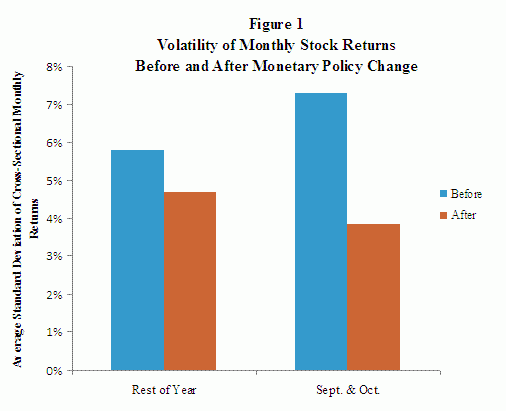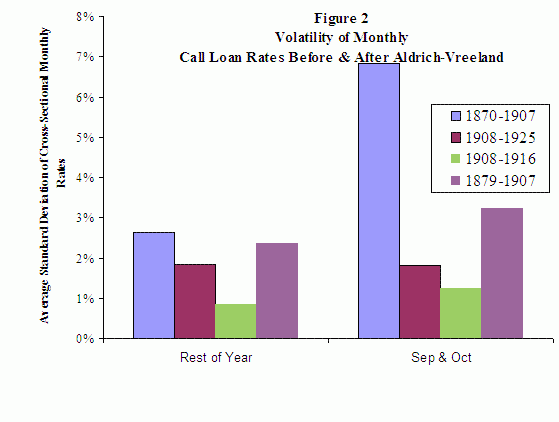The recent subprime mortgage crisis raises serious questions about the role of a lender of last resort and the appropriate role of monetary policy. Academics, policymakers, and the financial press have debated the extent to which central banks should intervene in the marketplace, provide liquidity, and even purchase the non-performing assets of troubled financial institutions. Although economists, Washington insiders, and the media may debate the extent to which the lender of last resort function should be intensified in wake of the current financial market meltdown, proponents and opponents of monetary policy generally agree that it is very difficult to identify the effect of the lender of last resort function on financial markets.
Fortunately, history provides some insight into the importance of a lender of last resort in dealing with a financial crisis, especially the provision of liquidity by financial institutions to help cash-strapped firms in the short run. Following the Panic of 1907, which was accompanied by one of the shortest but most severe financial crises in American history, the US Congress passed two important pieces of legislation that established a lender of last resort: (1) the Aldrich Vreeland Act of 1908 which allowed banks to temporarily increase the money supply during a financial crisis, and (2) the Federal Reserve Act of 1913 which replaced Aldrich-Vreeland and established a public central bank in the US (Moen and Tallman, 2000).
The two acts were designed to increase the elasticity of the money supply, which was largely fixed by the supply of gold and the requirement that banks could only issue notes if they were sufficiently backed by US government bonds. The money supply was especially inelastic during the fall harvest seasons when the financial markets tended to be illiquid as cash moved from the money centre banks to the interior to finance the harvesting of crops. The financial stringency made New York financial market vulnerable to banking and financial crises in the fall as financial institutions were often forced to call in stock market loans in response to large unexpected withdrawals of cash in response to a greater than expected harvest season. Indeed, several of the largest financial crises of the National Banking Period (1870-1913) occurred during the fall harvest season including 1870, 1890, 1893, and 1907 (Kemmerer, 1910; Miron, 1986; Sprague, 1910).
A lender of last resort reduces financial volatility
In work with Asaf Bernstein, we use the seasonal nature of financial crises during the National Banking Period as an identification strategy to isolate the impact of the introduction of a lender of last resort on financial markets (Bernstein, Hughson, and Weidenmier 2008). We compare the standard deviation of stock returns in September and October over time before and after the introduction of a lender of last resort. The identification strategy should isolate the effects of the lender of last resort function on interest-rates and stock returns from other macroeconomic shocks. Wohar and Fishe (1990), for example, argue that World War I and the closure of the New York financial markets played an important role in the change in the stochastic behaviour of interest rates, in addition to the founding of the Federal Reserve. Given that these events all occurred around the same time, they argue that it is difficult to separate out the effects of these different events on interest rates. Our strategy enables us to identify the effect of the introduction of the lender of last resort because if the lender of last resort is responsible for what we find – lower volatility in financial markets - the effect should be largest in September and October.
We investigate stock volatility for two reasons: (1) stock volatility typically rises prior to the onset of a recession (i.e., the current financial crisis) and (2) given the poor quality of high frequency macroeconomic data from the National Banking Period, we can use stock volatility as a metric to provide some insight into the chicken and egg problem: do financial crises have real effects or do real shocks cause financial crises? If the former is true, then the introduction of a lender of last resort should reduce financial market volatility. As shown in Figure 1, stock volatility was more than 40% lower in the pre-lender of last resort period (1870-1908) versus the period 1908-1925. Although we find that stock volatility in September and October was larger than the other ten months of the year prior to the monetary regime change, this was no longer true after the introduction of a lender of last resort. We find similar results using the call loan interest rate, the interest rate financial institutions charged investors to buy stocks on margin. Figure 2 shows that interest rate volatility declined more than 70% in the months of September and October after the establishment of a lender of last resort. These volatility reductions are statistically significant at conventional levels.
The dramatic decline in volatility during the months of September and October has several implications for today’s policymakers and the current global financial crisis. First, financial crises can have large economic effects. Second, the provision of liquidity by a lender of last resort can be very important for containing the spread of a financial crisis that can have significant macroeconomic economic effects. Third, the reduction in uncertainty associated with a lender of last resort is likely to increase investment and shorten the duration of recessions. Fourth, while our analysis provides some insight into the importance of containing a liquidity crisis, it has less to say about the role of a lender of last resort when the solvency of financial institutions is uncertain.
References
Bernstein, Asaf, Hughson, Eric, and Marc D. Weidenmier. (2008). “Can a Lender of Last Resort Stabilize Financial Markets? Lessons from the Founding of the Fed.” NBER Working Paper.
Kemmerer, E.W. (1910). “Seasonal Variations in the New York Money Market.” American Economic Review 1(1):33-49.
Miron, Jeff (1986). “The Nominal Interest Rate, Seasonality, and the Founding of the Fed.” American Economic Review.
Moen, Jon and Ellis Tallman. (2000). “Clearinghouse Membership and Deposit Contraction during the Panic of 1907.” Journal of Economic History 60(1):145-63.
Sprague, O.M. (1910). “A History of Financial Crises under the National Banking Period.” Washington: U.S. Government Printing Office.
Fishe, R. P. H. and M Wohar (1990). “The Adjustment of Expectations to a Change in Regime: Comment.” American Economic Review 80(4): 531-555.




